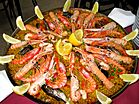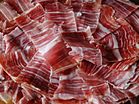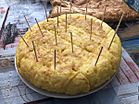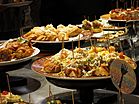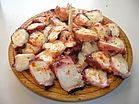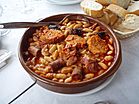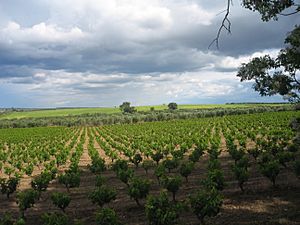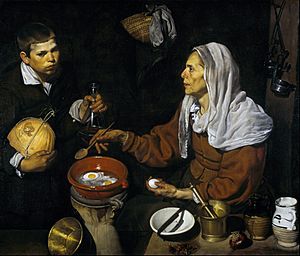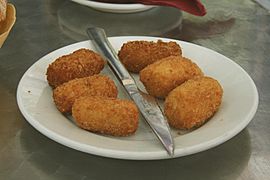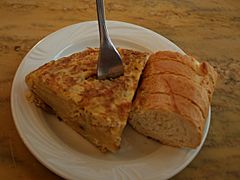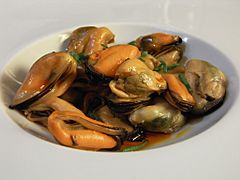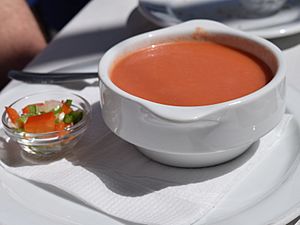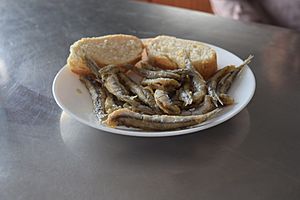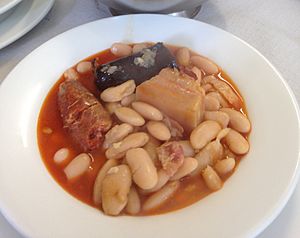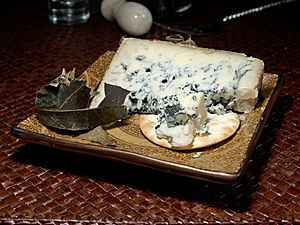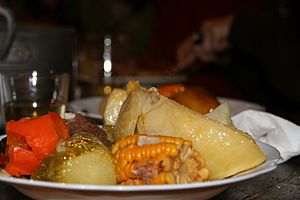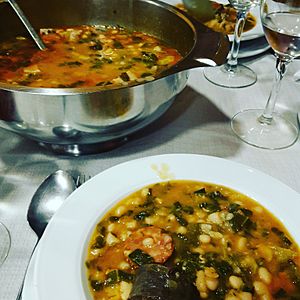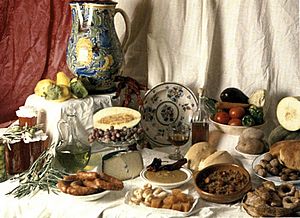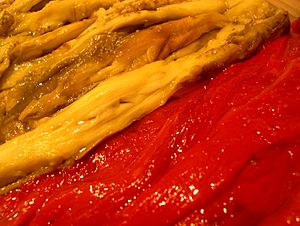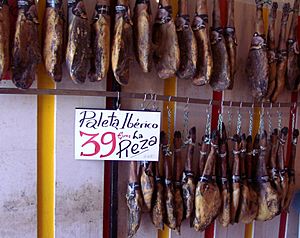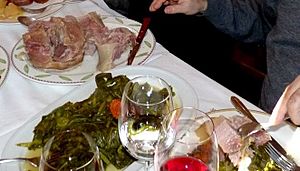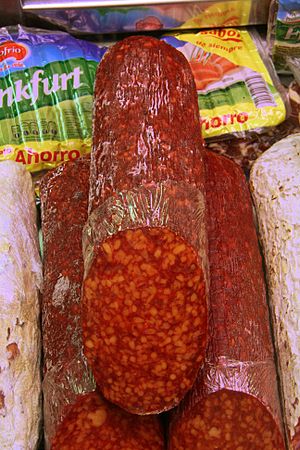Spanish cuisine facts for kids
Spanish cuisine is all about the yummy food traditions from Spain. Olive oil is super important in Spanish cooking. Spain actually makes the most olive oil in the world! It's used to make many veggie sauces called sofritos.
Common herbs include parsley, oregano, rosemary, and thyme. Garlic is used in almost every Spanish dish. The most popular meats are chicken, pork, lamb, and veal. People also eat lots of fish and seafood regularly.
Contents
History of Spanish Food
Ancient Times
Long ago, people in Spain ate nuts and acorns as main foods. The ancient Greeks and Phoenicians brought grapevines and olives to Spain. This is why Spain is now the biggest producer of olive oil. During the Roman times, people in southern Spain mostly ate bread, wine, and oil. These came from the "Mediterranean triad": wheat, grapes, and olives.
Middle Ages
The Visigoths, an old European group, helped spread the idea of drinking fermented milks. They also preferred not to mix water with wine.
Rice probably came to Spain around the 6th century. Later, in the 8th century, Arabs brought new ways to grow rice. They also introduced new crops like sugar cane, watermelon, lemon, and oranges. Other foods they brought were spinach, eggplant, peach, apricot, saffron, and almonds.
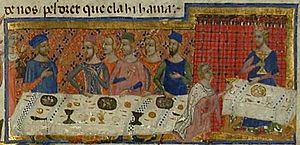
The Moors, who were Arabs from North Africa, also started the art of pastry-making. They introduced escabeche, a way to preserve food using vinegar. Many famous Spanish dishes come from Moorish cooking. These include ajo blanco, salmorejo, gazpacho, albóndiga (meatballs), mojama, fideuà, and turrón (a sweet nougat).
Jewish people in Spain also had their own special dishes. They followed rules about what they could eat, like draining blood from meat and avoiding bacon. Potajes (stews) were important, especially adafina, a slow-cooked stew.
The first cookbooks in Spain appeared around the 1300s and 1500s.
Modern Era

When Europeans arrived in the Americas in 1492, many new foods came to Spain. These included tomatoes, potatoes, maize (corn), bell peppers, spicy peppers, paprika, vanilla, and cocoa (for chocolate). Spain was the first place where chocolate was mixed with sugar to make it less bitter.
In return, foods like rice, grapes, and olives traveled from Spain to the Americas. Spain was like a bridge connecting the food of Europe and the New World.
By the 1700s, American ingredients like peppers and tomatoes were fully part of Spanish cooking. They added strong new flavors. Many traditional Spanish dishes, like tortilla de patata (potato omelette), wouldn't exist without these new foods. Gazpacho, salmorejo, and pan con tomate (bread with tomato) also use tomatoes from the Americas.
In the late 1800s and early 1900s, Spanish food experts worked to create a "national cuisine." They wanted Spaniards to recognize their own unique dishes. For example, some suggested olla podrida (a hearty stew) as a national dish.
A very popular cookbook, 1080 recetas de cocina by Simone Ortega, was first published in 1972. It became one of the best-selling books in Spain. It included many Spanish and French recipes.
TV cooking shows started in Spain in 1984.
Meal Routines

Spaniards usually start their day with a continental-style breakfast (desayuno). This might include coffee, milk, hot chocolate, biscuits, magdalenas (small cakes), or churros. Toasts with oil, tomato, or butter are also very common.
Because there's a long time between breakfast and lunch, people often have a mid-morning snack.
Lunch (el almuerzo or la comida) is the biggest meal of the day in Spain. It usually starts between 2:00 pm and 2:30 pm and finishes around 3:00 pm to 3:30 pm. After lunch, people often enjoy sobremesa, which is time spent chatting at the table.
At home, lunch usually has one or two main dishes and a dessert. This might be a soup, a salad, a meat or fish dish, and then fruit, yogurt, or something sweet. Small portions called Tapas are often served before or during lunch.
La cena, which means dinner or supper, is eaten later, between 8:30 pm and 10 pm. It's usually a lighter meal with one main dish and dessert.
Since dinner is late, an afternoon snack called la merienda is common around 6 pm. People might have coffee, something sweet, a sandwich, or fruit.
Some popular dishes eaten all over Spain include croquetas (croquettes), paella (a rice dish), ensaladilla rusa (potato salad), gazpacho (cold vegetable soup), and tortilla de patatas (Spanish omelette). People even argue about whether to put onion in a Spanish omelette!
-
Packaged gazpacho
Tapas are small appetizers served before or during lunch or dinner. Sometimes, bars give you free tapas when you order a drink. Besides the dishes mentioned, other famous tapas include mejillones en escabeche (marinated mussels), gildas, albóndiga (meatballs), and torreznos (fried pork belly).
Spanish Regional Foods
Spain has many different types of food depending on the region. Here are some traditional Spanish meals from different areas:
Andalusia
Andalusian cuisine has food from the countryside and the coast. This region uses the most olive oil in Spain. The most famous Andalusian dish is gazpacho. It's a cold soup made with five vegetables, vinegar, water, salt, olive oil, and old bread crumbs. Other cold soups are poleá and salmorejo.
Snacks with olives are common. Meat dishes include flamenquín (fried pork rolls), pringá (a mix of meats), and oxtail stew. Fish dishes include pescaíto frito (deep-fried fish) and soldaditos de Pavía (fried cod). A common breakfast is a traditional Andalusian breakfast, which is now popular all over Spain.
Cured meats like Serrano ham and Iberico ham are popular. Drinks include anise liqueur, wines (like Malaga and Jerez), and sherry brandy.
Aragon
Aragonese cuisine comes from rural and mountainous areas. The flat central part of Aragon has the most special foods. Since lambs are raised in the Pyrenees mountains, a famous dish is asado de ternasco (roast lamb). It's cooked with garlic, salt, and bacon fat. Pork dishes are also very popular.
Legumes are important, but the most popular vegetables are borage and thistle. For cured meats, jamón de Teruel and ham from Huesca are often used. Queso de Tronchón is a notable cheese. Sweet treats include frutas de Aragon (candied fruits) and maraschino cherries.
Asturias
Asturian cuisine has a long history, linked to Celtic traditions. One of its most famous dishes is fabada asturiana. This is a traditional stew made with white beans, sausages (like chorizo and morcilla), and pork. Another well-known dish is fabes con almejas (beans with clams). Asturian beans can also be cooked with hare, partridge, prawns, or octopus.
Pork foods like chosco and bollu preñáu (chorizo-stuffed bread rolls) are popular. Common meat dishes include carne gobernada (roasted veal) and cachopo (a crispy, breaded veal steak with ham and cheese). Fish and seafood are also very important, thanks to the Cantabrian Sea.
Asturian cheeses are popular in Spain. The most famous is Cabrales cheese, a strong, blue cheese from the Picos de Europa mountains. Other popular cheeses are gamonéu and afuega'l pitu. These cheeses go well with local cider, a low-alcohol drink made from Asturian apples.
Asturian cider is poured from a height to make it bubbly. You drink it right away in small sips.
Popular desserts are frisuelos (like crêpes, often with cream or apple jam), rice pudding, and carbayón (puff pastry cakes with almond filling).
Balearic Islands
Balearic cuisine is very much like other Mediterranean foods. The islands have been taken over many times, which has left some food influences. Well-known foods include sobrassada (a cured sausage), arroz brut (rice dish), mahón cheese, and mayonnaise. Dishes include tumbet (vegetable bake) and roasted suckling pig. Popular desserts are ensaïmada (a spiral pastry) and tambor d'ametlla. Balearic food is a great example of the Mediterranean diet, using lots of olive oil, legumes, whole grains, fruits, vegetables, and fish.
Basque Country
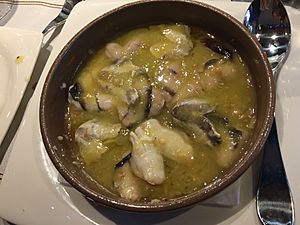
The food of the Basque Country is very rich and varied. Eating is a big part of the culture here. Meat and fish dishes are highlights. For fish, cod (bacalao) is cooked in many ways, like bacalao al pil pil. Anchovies, bream, and bonito are also popular. A famous dish is changurro (spider crab). Common meat dishes include beef steaks and pork loin.
Txakoli or chacolí is a special white wine from the Basque Country. It's known for being a bit sour and having less alcohol.
Canary Islands
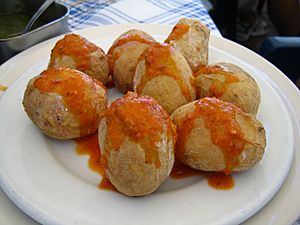
The Canary Islands have unique food because they are in the Atlantic. They were part of old trade routes to the Americas, so their food is a mix of different traditions. Fish (fresh or salted) and potatoes are main foods. People also eat a lot of cheese, fruits, and pork meat. The warm weather helps grow tropical fruits like bananas, yams, mangoes, avocados, and persimmons, which are used a lot in cooking.
The native people, the Guanches, ate gofio (a flour from toasted grains), shellfish, and goat and pork. Gofio is still eaten today.
A sauce called mojo is very common. It comes in many forms to go with different dishes. Fish dishes often use a "green mojo" made from coriander or parsley. Roasted meats use a red mojo made from chili peppers, called mojo picón.
Classic Canary Islands dishes include papas arrugadas (wrinkly potatoes), almogrote (cheese spread), and rabbit in salmorejo sauce.
Popular desserts are truchas (pastries with sweet potato or pumpkin), roasted gofio (with nuts and honey), and quesillo (a type of flan).
Cantabria
A popular Cantabrian dish is cocido montañés (highlander stew). It's a rich stew made with beans, cabbage, and pork.
Seafood is widely used. Bonito (a type of tuna) is in the typical sorropotún or marmita de bonitu (tuna pot).
Good quality meats include Tudanca veal and game meat.
Cantabrian pastries include sobaos (sponge cakes) and quesadas pasiegas (cheesecakes). Dairy products include Cantabrian cream cheese and smoked cheeses.
Orujo is a type of brandy from Cantabria. Cider (sidra) and chacoli wine are also popular.
Castile-La Mancha
In Castilla-La Mancha, the food shows its history with shepherds and peasants. Wheat and grains are very important. They are used in bread, soups, gazpacho manchego, and gachas (porridge). Garlic is a main ingredient, used in dishes like ajoarriero.
Some traditional recipes are gazpacho manchego, pisto manchego (vegetable stew), and migas ruleras (fried bread crumbs). Morteruelo is a type of foie gras. Manchego cheese is also very famous.
Since the land is dry, there are many small animals like rabbits and birds (like pheasants, quails, and partridges). So, game meat is used in dishes like conejo al Ajillo (rabbit in garlic sauce) and perdiz escabechada (marinated partridge).
Castile and León
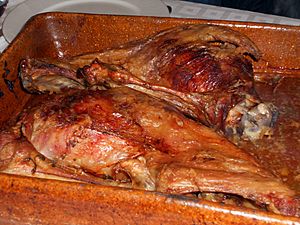
In Castile and León, special dishes include morcilla (a black pudding with spices), judión de la Granja (large beans), sopa de ajo (garlic soup), Cochinillo asado (roast piglet), and lechazo (roast lamb). Other foods are botillo del Bierzo (a sausage dish) and hornazo (a meat pie) from Salamanca.
Important wines in this region include the strong wine of Toro, red wines from Ribera del Duero, and white wines from Rueda.
Catalonia
The food of Catalonia comes from a rural culture and is very rich. The first cookbook in Spain was written here. Catalan cuisine has foods from three areas: the coast (seafood), the mountains, and the inland areas. Some famous dishes are escudella (a stew), pa amb tomàquet (bread with tomato), and escalivada (roasted vegetables).
Important sauces are romesco sauce and aioli.
Cured pork foods include botifarra (white and black sausages) and fuet (a thin, cured sausage).
Fish dishes include suquet (fish stew) and arròs negre (black rice).
Desserts include Catalan cream, carquinyolis (biscuits), and panellets (small cakes).
La Rioja
La Rioja is known for using meats like pork and cold cuts. Lamb is also very popular, especially chuletillas al sarmiento (lamb chops cooked over vine shoots). Veal is common in the mountains. A well-known dish is Rioja style potatoes and fritada (fried vegetables). Pimientos asados (roasted peppers) is a notable vegetable dish.
La Rioja is famous for its red wine. Most dishes are served with this wine.
Extremadura
The food of Extremadura is simple, made by shepherds. It's very similar to the food of Castilla. Extremadura has a lot of pork. It's known for raising pigs, especially the Iberian pig, which eats acorns in the fields. Iberian pork products like sausages are common in stews.
Other meat dishes are lamb stew or goat stew (caldereta de cordero and caldereta de cabrito). Game meats like wild boar and partridge are also highlights.
Special cheeses from the region are quesos de torta, which are sheep milk cheeses. Famous desserts include leche frita (fried milk) and pestiños (fritters). Many sweets come from convents.
Cod dishes are known, and tench is a traditional freshwater fish. Soups are often bread-based. Pennyroyal mint is sometimes used to flavor gazpachos.
The region of La Vera makes pimentón de la Vera, which is smoked paprika. It's very popular in Spain and used a lot in Extremaduran cooking.
The region is also known for its vino de pitarra, which is homemade wine.
Galicia
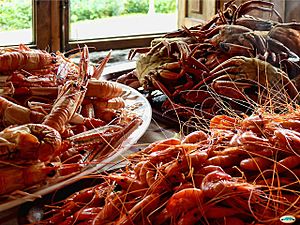
Galician food is well-known in Spain because many people from Galicia have moved to other parts of the country. Galicia shares some food traditions with other Celtic nations in Atlantic Europe. One of the most famous Galician dishes is soup. Another notable dish is pork with turnip tops, often eaten during carnival. Caldo de castañas (chestnut broth) is popular in winter. Pork products are also common.
Seafood dishes are very famous and varied. These include Galician empanadas (savory pies), octopus, scallops, crab, and barnacles. In Santiago de Compostela, travelers used to eat scallops when they arrived.
Among the many dairy products is queso de tetilla (a breast-shaped cheese).
Queimadas are a special way of preparing orujo (a strong alcoholic drink). It involves mixing the drink with orange or lemon peels, sugar, or coffee beans, and then setting it on fire in a ritual.
Famous sweets include tarta de Santiago (almond cake) and filloas (like crêpes).
Since cattle farming is common in Galicia, a lot of red meat is eaten, usually with potatoes.
Madrid
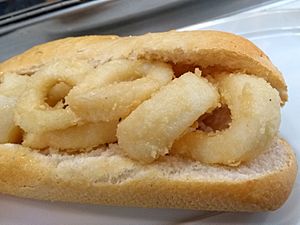
Madrid became the capital in 1561. Because many people moved there, Madrid's food often comes from other Spanish regions. Madrid was one of the first cities to have restaurants.
Murcia
The food of the region of Murcia is influenced by Manchego cuisine. Murcia is known for its many fruits. Some outstanding dishes are zarangollo (scrambled eggs with zucchini and onion) and aubergine a la crème. A typical sauce here is moje, used with meat.
Regional dishes include michirones (beans with bay leaves, hot peppers, and garlic) and sopa de mondongo (tripe soup).
Some meat products from Murcia are morcilla (black pudding) flavored with oregano, and longaniza (sausage).
For fish and seafood, there are golden salt fish, Mar Menor prawns, and baked octopus.
Rice dishes are common, including arroz y conejo (rice with rabbit) and paella Valenciana (rice with rabbit and snails).
Desserts are plentiful, like paparajotes (lemon leaf fritters) and stuffed pastries.
This region also has special wines from Jumilla, Bullas, and Yecla.
The food of Navarra is very similar to Basque cuisine. Two main dishes are trucha a la Navarra (Navarra-style trout) and cordero al chilindrón (lamb stew).
Salted products are common, like chorizo de Pamplona (a type of sausage). Lamb and beef from Navarra have special quality labels. Cheeses include Roncal cheese and Idiazabal cheese. Typical alcoholic drinks include claret wine and pacharán (a sloe berry liqueur).
Valencia
The food of Valencia has two parts: rural (from the fields) and coastal (seafood). A popular dish from Valencia is paella, a rice dish cooked in a round pan with vegetables and meats (originally rabbit and chicken). Other common dishes are arròs negre (black rice) and fideuá (noodle paella).
Coastal towns provide fish, leading to popular dishes like all i pebre (fish stew).
Desserts include coffee liqueur, Alicante chocolate, turrón (nougat) from Alicante and Jijona (especially at Christmas), and horchata (a sweet drink).
Customs
It is a tradition to make and eat small honey cakes (galletas de miel) for the celebration of Corpus Christi.
Images for kids
-
Spanish chef Ferran Adrià
See also
 In Spanish: Gastronomía de España para niños
In Spanish: Gastronomía de España para niños


